Its a well known fact that thermal transfer labels are ideal for long shelf life products! Thermal transfer labels are your go-to for durability, as they can be very legible for as long as 6 months!
But, before we start printing, let’s make sure we get the setup and process right so your labels come out crisp, clear, and ready for action.

Why Choose Thermal Transfer Labels?
First off, why thermal transfer labels? They’re known for long-lasting, smudge-resistant prints—no faint barcodes or smeared details here! With a thermal transfer printer, the image (or text) is created by heating a ribbon that transfers ink onto the label. It’s a bit like ironing a design onto a T-shirt, but way more precise. Plus, these labels stand up to heat, moisture, and heavy handling, making them perfect for a variety of uses.
How to Print Thermal Transfer Labels Like a Pro
Step 1: Gather Your Supplies
For printing thermal transfer labels, you’ll need three key things:
1. Thermal Transfer Printer: Not just any printer will do. Thermal transfer printers are specifically designed for these labels, using a heat method that bonds the ink to the label.
2. Ribbon: The ribbon is essential here—it holds the ink that’ll end up on your labels. Thermal transfer ribbons come in different materials like wax, resin, or a blend, depending on the durability you need.
3. Labels: Make sure you’re using thermal transfer labels (not direct thermal). They’re made to work with ribbons, unlike direct thermal labels that work without ink ribbons.
Step 2: Load Your Printer Properly
Alright, supplies are ready—now comes the loading part. This might seem obvious, but even the smallest misalignment can lead to wrinkled ribbons or blank spots on labels.
1. Insert the Ribbon: Follow your printer’s specific instructions for loading the ribbon. Make sure it’s placed snugly, as any loose ribbon might create unwanted gaps in your print.
2. Insert the Labels: Place the labels into the tray, aligning them neatly. Remember that thermal transfer printers are a bit more particular about label positioning than your average printer.
Step 3: Adjust Printer Settings
With everything loaded up, it’s time to fine-tune the settings. Most thermal transfer printers let you adjust things like heat (or darkness), speed, and print quality.
Step 4: Run a Test Print
Before printing hundreds of labels, always run a test. This lets you catch any minor issues, like misaligned text or faint prints. It’s a quick way to save time (and frustration) later. If the test looks good, you’re ready to go.
If not, try these fixes:
- Adjust the darkness setting if prints are too light.
- Realign the ribbon or labels if there’s any smudging.
- Clean the printhead if you see streaks—dirt or residue can build up and interfere with printing quality.
Step 5: Print, Peel, and Stick
Once the test looks sharp, start your batch. Peel off a label to check for durability, clarity, and adherence to your packaging or product. It should feel secure, clear, and resistant to smudging.
By following these tips, you’ll get high-quality thermal transfer labels every time. And if you’re looking to stock up on supplies, 4x6Labels has a wide selection of ribbons and label rolls. We’ve got you covered so you can print with confidence, knowing your labels will hold up through thick and thin.
Ready to get started?

